Starting Out
 When first starting out on your journey to find out more about your family history the place to begin is with you. Write down everything you know about your immediate family, your parents, their siblings, your grandparents etc. going back as far as you can. Gather together any birth marriage and death certificates that you, and other members of your family may have, along with any other memorabilia such as photos, letters, medals or family bible and attach them to the relevant people in your skeleton tree.
When first starting out on your journey to find out more about your family history the place to begin is with you. Write down everything you know about your immediate family, your parents, their siblings, your grandparents etc. going back as far as you can. Gather together any birth marriage and death certificates that you, and other members of your family may have, along with any other memorabilia such as photos, letters, medals or family bible and attach them to the relevant people in your skeleton tree.
If there are members of the generation above you who can help, your next stop is with them. They can help you check the information you already have, and, hopefully, will be able to fill in any gaps. This step is essential because perhaps you remember ‘Uncle Jack’ and ‘Auntie Nell’ but your older relative will be able to tell you that they were really ‘James’ and ‘Ellen’, very useful when it comes to searching for them in the birth indexes. They might also have other birth, marriage and death certificates, photos and documents that will help you with your search. It’s a good idea to take a notebook with you and to jot down everything they say, even if at the time you think it’s of no importance, because one day that unimportant thing might well turn out very useful. If the person is willing, don’t hesitate to go back and ask the same, or more questions, it’s amazing what comes back to people once they start thinking about the past.
If you have been lucky, you now have a good idea of your family, and the areas where they lived, going back a couple of generations. At this point it’s very easy to get carried away and start trying to go back as far as possible, on as many lines as possible, all at the same time. As hard as it might be, don’t let this happen to you! It’s much better to choose one line at a time and to work your way back methodically, making a note of every new bit of information along the way. It’s also a good idea to decide how you are going to store and present all the information before you end up with bits of paper scattered all over the house.
Start with the ancestor you would like to know more about, find them in the birth indexes and send off for their birth certificate. The birth certificate will give you the name of their parents and, if your ancestor was born after the September quarter of 1911, you’ll get the added bonus of their mother’s maiden name as well. Armed with the parents’ names you can now try and find their marriage entry. This in turn will give you the names of the bride and groom’s fathers and their occupations. And back you go, step by step, for each generation. Have a look at our cautionary tales page to see the importance of certificates in your research.
The censuses for England and Wales from 1841 to 1911 are available for consultation online and they are another useful source for helping you to follow your family back and to add some colour to your tree. A typical census entry will show you where your ancestor was living, their occupation, their age, if they were married or not, who they were living with and, from 1851 onwards, their place of birth. You might find extra siblings for your ancestor, or be able to confirm a link between two families if they had a member of the other family staying with them on census night. The places of birth column can also be a clue to how the family has moved about the county or country, giving you an idea of where to look for a birth entry.
A census entry can also give a glimpse of what your ancestor’s life was like. You can see the kind of area they were living in, by looking at their neighbours and the jobs they had. You can see if they had any extended family living near them and if they are living near people who would one day become part of the family. It’s only a snapshot of their life, on one night, but it can be fascinating.
You should be warned, however, that people were often economical with the truth when answering the questions; husbands and wives might not necessarily be married, children might not all be from the same mother and father and ages and places of birth can change from one census to the next. This is why it is always wise to back up any information added to your family tree from censuses with certificates.
Once you get past 1837 and the introduction of civil registration in England and Wales, you will need to start consulting parish registers to find entries for Christenings, Marriages and burials.
This is only a basic introduction to beginning your family history research. More detailed information on the sources mentioned and on finding out more about your family’s past, can be found by clicking on the links in the text, and in the following pages of the website. If you have any questions, no matter how basic they seem to you, be sure to visit our forum where you will get a swift response from our helpful and friendly members. Research board
